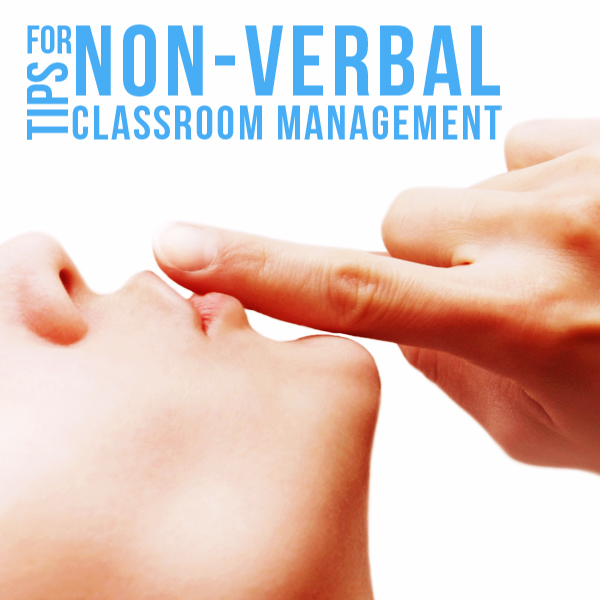This is the second post in the new series I’m introducing on The Cornerstone called Real Teachers, Real Tips. Each month, I’ll invite one educator to share a few classroom management tips that have worked in his or her classroom. I’m hoping to feature a wide cross-section of teachers from all different parts of the world, at all different grade levels, in all different teaching scenarios. Want to be featured here? Just fill out the guest blog form!
August’s featured teacher is Tammi Pittaro, a super talented educator who’s been in the field for 35 years!! Thank you, Tammi, for sharing your perspective here.
Hello! My name is Tammi from presentlygifted.org. I am a fairly new blogger and mostly write about teaching students with high academic potential. I am excited and honored to be here as the guest blogger! Angela has asked me to share a post about non-verbal classroom management. She believes, as I do, that managing a classroom successfully is the backbone of good teaching. But first, just a little about me…

I live and teach in southeastern New Jersey, not far from the bright lights of Atlantic City and the Pine Barrens forest. I have taught in the same school district for the past 35 years. About half of this time has been at the elementary level as a classroom teacher, and the other half as a gifted and talented/enrichment specialist in grades K through 8. Currently, I teach and coordinate our district’s pullout gifted and talented program. I teach over 100 identified students in small groups in three schools during the course of the week, as well as working with whole classrooms of kindergarten students. My program is project-based and concentrates on developing creativity, critical thinking skills, problem solving and how to do authentic research. A good dose of classroom technology is thrown into the mix as well. I love, love, love to teach and work with kids of all ages, and after 35 years, teaching continues to make me smile everyday!
As I am gearing up for a new school year, I am thinking about the basics. In my opinion, classroom management is the glue that holds everything together. A strong classroom management system has always been important to me, but as a teacher who works with various groups of children each day, I have come to truly realize that it is the key to successful teaching. Since the time I have with my students is limited, it is important that we make the most of every moment. Classroom focus needs to be on learning instead of discipline. There is just too much curriculum to teach and too little time for interruptions due to student behaviors such as talking, daydreaming, distracting others and fooling around. I talk all day long as it is, so I don’t want to use my voice any more than I need to! Nonverbal classroom management techniques can really help to make the classroom a more productive and happy place for everyone.

What does nonverbal classroom management look like and how can a teacher keep students focused on learning without using words or sounds? Here are five very simple, no-cost, low-tech ways that have worked for me over the years.
1. One, Two, Three…Eyes on Me!
I have found that making eye contact with each child early and often in the day or the period helps him or her stay on track in the classroom. I make sure I greet each student warmly by name and look him or her in the eye upon entering my classroom. Then, during direct teaching or working with a few students, I make sure I continue to do so. Students are more likely to stay on task and behave appropriately when they know the teacher is watching. Making eye contact, especially in Western cultures, signifies respect, interest, appreciation, trust and friendship. It’s an important skill to teach young children and to model as you teach.
2. Work the room
Where you stand or teach can make a big difference. Moving around as you teach helps keep your students focused. Without skipping a beat, you can move nearer to those students who might be distracted or fooling around. Your proximity will send a message to get back to business, and you don’t usually have to say a word. Pause for a few moments near the student who has been off-task and teach from there for a bit before moving on. A little eye contact helps here as well. A good practice while students are working independently or in small groups is to keep moving among them. I’ve observed (and experienced first hand) that when teachers sit, trouble can be brewing at the opposite end of the classroom! And most of us can use the extra physical activity!
3. Sign Language
I found sign language posters by Rick Morris (www.newmanagement.com) years ago, and I have used them ever since with students in grades K through 8. I use the first five, although he has now has fourteen in all. I have them posted in my classroom and teach them the first day of school. They are easy for the students to learn and very effective, especially in larger groups. Students like them, too! Check out Rick’s website for more good tips!
4. Keep a silent eye on the clock (or your watch)
Want to get your class quiet quickly? Just look at the clock, or your watch, assume a sad expression and shake your head just a bit. Don’t say a word! Your students will get the message loud and clear. If you deduct the time you have waited from allotted preferred activity time, such as recess or classroom games (see Tools for Teaching: Discipline, Instruction, Motivation by Fred Jones), you won’t have to wait very often for silence. I first observed this during student teaching by an experienced teacher, and it still works after all these years!
5. “S-O-R-R-Y”
In my experience, this is really effective in the primary and elementary grades. On the first day of school, explain to your students that if you ever have to write SORRY on the board, it will mean that the class has lost a privilege they enjoy, such as free time or recess. When undesired behaviors occur, start to print the word “S-O-R-R-Y” one letter at a time on the board without making a big deal about it. Don’t erase the any of the letters you have written until the end of the day or after the preferred activity. Rarely will you get to “Y.” I promise! Works like a charm.
Have you tried (or would you like to try) any of these strategies with your kids? Do you use other non-verbal classroom management techniques in your classroom? Tell us in the comments!

Angela Watson
Founder and Writer
Sign up to get new Truth for Teachers articles in your inbox
Discussion
OR

Join our
community
of educators
If you are a teacher who is interested in contributing to the Truth for Teachers website, please click here for more information.

















I find sitting down at my desk is a very clear indicator that they need to be quiet, I don’t get up until they are quiet.
3 simple hand signs help me a lot. Holding up your hand is participation in our learning activities, so for the bathroom, it’s crossed fingers; for pencils, just hold it up; for a drink from the fountain in our room, shape your fist like a cup. A simple nod from me keeps me on track and serves their needs.
I use 1,2,3 eyes on me a little differently with my third graders. I say “1,2 “and then they say “don’t let me get to 3”. They are quiet instantly and you have their attention. If you do get to three they lose time from recess or free time.
Good post. I have the methodology that less is more.
Each class period I write what they need on the board and after that I write ONLY. I write underneath that “Time wasted so far ______ min.”
I step away from the board and anchor myself to the corner of the room …..and wait. As the time moves I write 1, 2,3, etc min. Wasted.
As they start to comply I acknowledge with a very public “Thank you ____.” And repeat it for all compliers.
As the others hear Thank you, they start to see what their classmates are being thanked for and mimic their action.
Some students are still Lost in the Sauce so I just point to him and then to my eyes then to the board. At this point the other students are directing him, which is exactly what I want; I want my students to police themselves. It’s much more received coming from a peer.
When they have all of their things ready, I wait until the room is “Pin Drop” quiet.
Then in my lowest, voice usually a level below normal, I quietly tell them what the lesson is today.
If they wasted more that 6 minutes, I very calmly tell them that those ____ minutes are gone forever. That’s ____ minutes we don’t have to review a lesson or reexplain a point, or just when you ALMOST were THIS CLOSE to understanding and you just needed ____ minutes more…..the bell rang:(
I however, remind them that the test/quiz/exam is STILL coming whether they’re ready or not. “The time you wasted was your OWN.”
This works very well. My aim is to make my students as independent as possible, train them to READ AND FOLLOW instructions.
The board gets them reading as soon as they walk in the door.
Instructions are always simple and followable. As I teach boys, I’m careful not to “Layer” instructions. Simple short sentences and usually not more than 2-3 things at a time.
And yes, I have had 2 times in the last 12 years where the whole period was wasted.
I stuck to my guns. On Day 1 I told my students I will not fight to talk in this class. I refuse. We BOTH can’t talk. So if you talk, I’ll STOP talking. I’ll START again when you STOP.
My last 5th grade class got the message and the next data bout 90% of them were compliant.
I’ve used this in grades 5 up to high school and EVEN in TEACHER STAFF MEETINGS. Yup!
Sometimes the teachers are worse than the students they complain about. Sad, but True.